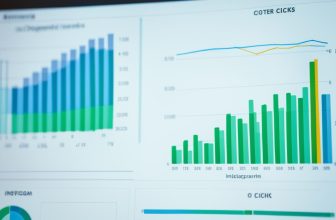In today’s rapidly evolving digital landscape, brands are keenly adopting social media benchmarking to elevate their digital footprint and capture the essence of what it means to measure social media success. This strategic pivot leverages social media metrics to compare and contrast a brand’s online vigor against that of its competitors. The practice centers on dissecting social media KPIs, which encompass engagement rates and follower count momentum, while scrutinizing the resonance of content outreach strategies. By learning how to effectively benchmark your social media performance, brands gain the latitude to fine-tune their online interactions as well as fortify their social media performance in a crowded marketplace.
The potency of benchmarking grounds itself in the premise that context is the foundation of high-quality analysis. Merely glancing at isolated metrics may portray a skewed picture of a brand’s stature. However, when these metrics are juxtaposed with industry standards and peers’ performance, they commission actionable insights that dictate market trajectories and strategic pivots. It is through such vibrant and insightful engagements that businesses come to realize the pinnacle of their communicative endeavors on social platforms.
Key Takeaways
- Recognize the importance of comparing your brand’s social media metrics to industry standards and competitors.
- Gain insights into how benchmarking can boost social media KPIs and overall performance.
- Understand the role of thorough competitor analysis in social media performance.
- Learn why engagement rates and follower growth are critical components of social media success.
- Discover the benefits of employing benchmarking for strategic social media decision-making.
Understanding Social Media Benchmarking
In the fast-paced world of digital marketing, social media benchmarking has emerged as a linchpin for understanding the performance and influence of an organization’s online presence. By leveraging social media tracking and analysis, businesses can peer into the mirror of competitive dynamics and carve out more robust positions in their respective markets. The essence of benchmarking lies in its ability to distill complex data into actionable insights, steering brands towards optimal engagement and outreach practices.
Defining Competitive Benchmarking in Social Media
At its core, competitive benchmarking is the strategic practice of measuring a company’s social media performance against that of its rivals. This process involves a detailed social media analysis of metrics and Key Performance Indicators (KPIs) that are critical for judging the success and resonance of social media content. In doing so, it equips organizations with the necessary standards and aspirational targets to continually enhance their digital strategy.
The Roles of Data-Driven Insights and Competitive Positioning
Without the lens of competitive benchmarking, companies might operate with a skewed view of their digital standing. The integration of social media analytics reveals a richer, data-driven tapestry of where a brand stands and, importantly, where it can aim to go. An impressive 92% of industry leaders affirm the pivotal role of benchmarking in establishing and maintaining competitive positioning—proof of its foundational role in strategizing for social media supremacy.
- Track engagement levels to identify content that truly resonates with audiences.
- Gauge post frequency to harmonize with audience preferences and industry norms.
- Monitor audience growth to ensure the trajectory aligns with overarching business goals.
Ultimately, these facets underscore the innate value of harnessing competitive benchmarking for not just meeting the industry standard, but exceeding it to gain a palpable competitive edge.
The Role of Metrics and KPIs in Social Media Analysis
At the heart of a successful social media strategy lies the adept use of metrics and social media KPIs. Driven by comprehensive social media analytics, these measures translate user interactions into discernible patterns that determine the efficacy of a brand’s online presence. From a simple ‘like’ to viral sharing, these signals are the compendium of success on social platforms.
Smart social media tracking not only scrutinizes your brand’s activities but also benchmarks them against competitors. This insight is crucial since it contextualizes your metrics within the wider industry landscape, revealing your performance’s true standing.
Below is an illustration of how different social media metrics can be segmented to extrapolate meaningful insights that aid in refining marketing strategies:
| Metric | Objective | Insight | Strategy Enhancement |
|---|---|---|---|
| Engagement Rate | Assess content interaction | Identifies what resonates with the audience | Optimize content types and posting schedules |
| Conversion Rate | Measure effectiveness of CTA | Evaluates ROI of social media campaigns | Tailor CTAs and A/B test different approaches |
| Reach | Gauge audience growth | Indicates brand awareness level | Expand influencer partnerships and hashtags |
| Follower Growth | Track audience expansion over time | Signals attractiveness of brand persona | Improve engagement tactics to retain and attract followers |
It’s not just about collecting data; the magic happens in the analysis. Advanced social media measurement tools help to interpret this plethora of data, spotlighting successful tactics and those that need a re-think. Engaging visual content might be driving your likes sky-high, but are your conversion rates reflecting this popularity? If not, perhaps your engaging posts aren’t as strategically aligned with your sales funnel as they could be.
Therefore, a blend of these metrics steers brand strategists to not only follow their performance but to seize opportunities for innovation. Social media, after all, is a dynamic battlefield where agility and astuteness determine the victors.
Strategies for Benchmarking Your Social Media Performance
With digital landscapes evolving rapidly, it’s crucial for brands to benchmark their social media performance effectively. Businesses encounter challenges when identifying the most impactful social media metrics and KPIs that will not only gauge performance but will also steer them towards strategic growth. There’s a multitude of strategies they can adopt, but it all starts with understanding the different types of benchmarking that can be employed.
Process, Strategic, and Performance Benchmarking Techniques
Process benchmarking digs into the specifics of day-to-day social media management, examining methodologies that increase engagement and customer satisfaction. Strategic benchmarking steps back to observe the broader landscape, taking into account brand positioning, influencer partnerships, and comprehensive content strategies. Performance benchmarking, on the other hand, is all about measurable outcomes—think follower engagement and content reach. This multi-faceted approach ensures that you have a holistic view of how to measure social media success.

Case Studies: Learning from Industry Leaders
Real-world case studies offer invaluable insights into successful benchmarking efforts. For instance, an analysis of the social media tactics of industry contenders like Ryanair and easyJet reveals how their distinct strategies involve playing to their unique brand strengths—Ryanair with its humor-driven approach and easyJet with content that underscores reliability.
Now, let’s break down a comparative analysis of different elements essential for robust social media benchmarking:
| Element | Ryanair | easyJet | Industry Average |
|---|---|---|---|
| Engagement Rate | High (Humor Content) | Moderate (Reliability Content) | Varies |
| Influencer Collaborations | Selective partnerships | Broad Campaigns | Industry-Specific |
| Customer Response Time | Within 1 hour | Within 2 hours | 1-3 hours |
| Content Strategy | Quirky & Engaging | Consistent & Informative | Mixed Approaches |
Initiating the Social Media Benchmarking Process
Embarking on a social media benchmarking journey is akin to charting a course through the competitive landscape to understand where you stand and where you can excel. This vital assessment commences with a strategic selection of competitors, sharpening the focus on those that closely align with your industry and audience. Social media tracking tools come into play here, enabling a meticulous gathering and analysis of their digital footprints.

Once competitors are in sight, it’s time to deploy a SWOT analysis. This approach dissects strengths, weaknesses, opportunities, and threats, offering a multi-angled perspective on your market position versus your rivals. The resulting insights are indispensable for an accurate social media analysis, fueling informed decisions and tactical pivots in your brand’s approach.
Firmly grounded in the intelligence derived from competitor analysis, the next step is to define your benchmarks. This requires more than a cursory glance at data; it demands a tailored set of metrics fashioned to mirror your internal ambitions while staying true to industry standards. Incorporating social media measurement techniques, these benchmarks act as a beacon to illuminate your brand’s progress and guide its voyage through the bustling social media seas.
| Key Performance Indicator | Your Brand | Competitor A | Competitor B | Industry Average |
|---|---|---|---|---|
| Engagement Rate | 4.5% | 3.8% | 5.2% | 4.0% |
| Follower Growth | 250/mo | 150/mo | 300/mo | 225/mo |
| Content Virality | 1.8% | 1.3% | 2.1% | 1.5% |
| Customer Response Time | 2h | 4h | 1h | 3h |
Armed with a solid strategy and precise benchmarks, stepping into the arena of social media can become less daunting and more deliberate. By nestling targeted tracking, thorough analysis, and meticulous measurement into the core of your social media operations, the path to not only benchmark your social media performance but also to elevate it becomes clear and attainable.
Interpreting Benchmark Data to Refine Social Media Strategies
The process of social media measurement is a crucial aspect of a brand’s market strategy. The intricate data harvested through social media analytics provides a clear roadmap for understanding and improving social media performance. It’s at this juncture that brands can translate the numbers into actionable tactics to elevate their online presence.
Understanding Social Media Analytics Tools and Reports
Leading brands leverage sophisticated analytics tools to dissect vast arrays of data. These tools offer detailed reports on various social media KPIs such as engagement, reach, and conversion rates, making it easier to understand which aspects of their strategy are performing well and which require reevaluation. Whether it’s through native platform analytics or third-party services, the insights gathered play a pivotal role in informing future initiatives.
Setting Realistic Social Media Goals Based on Industry Norms
Once the data is at hand, it’s imperative to set realistic and measurable goals. Benchmarking against industry norms allows brands to position themselves favorably within the competitive landscape. These goals, influenced by data and competitive insights, pave the way for sustained growth and continual engagement with the target audience.
Here’s a comparative table illustrating typical KPIs and industry benchmarks:
| Metric | Your Brand | Industry Average | Top Competitor |
|---|---|---|---|
| Engagement Rate | 4.5% | 4.0% | 6.0% |
| Follower Growth | 3% | 2.5% | 5% |
| Click-Through Rate (CTR) | 2% | 1.5% | 3% |
| Conversion Rate | 0.9% | 1.2% | 1.5% |
Effective use of social media analytics and benchmarks not only inspires a brand to reach and exceed average industry standards but also to aspire to be among the best in their niche. Regular analysis and social media measurement guide ongoing tweaks and changes to strategies, ensuring sustained performance and relevance within the digital sphere.
Conclusion
In the ever-evolving digital landscape, social media benchmarking stands out as a critical tool for brands looking to measure social media success and elevate their online engagement. By delving deep into the analytics of social media KPIs, companies gain vital insights that allow them to benchmark their social media performance with pinpoint accuracy. It’s this strategic employment of carefully tracked metrics that furnishes brands with the capacity to sharpen their competitive edge and truly resonate with their target audiences.
As brands endeavor to refine their strategies within this connected realm, the importance of benchmarking cannot be overstated. Harnessing the power of comparative analysis propels brands towards data-driven decision-making. With the application of robust benchmarking methodologies, businesses are not only privy to where they stand but also to where they can aspire to be. By setting their sights on enhanced social media performance, brands can craft compelling content and strategies that are both impactful and imbued with a deep understanding of industry competition.
Ultimately, the path to a commanding digital presence is paved with the insights derived from social media benchmarking. It’s a process that fosters a cycle of continual improvement, optimizing every post and interaction for maximum engagement. For brands aiming to thrive within the bustling marketplace, applying these analytics is the cornerstone of developing a dynamic and influential social media platform. A strong and calculated approach to social media is no longer a mere option—it’s an imperative for success.
FAQ
What is Social Media Benchmarking?
Social media benchmarking is the process of comparing your social media metrics and KPIs against those of your competitors or industry standards to gauge your brand’s performance and success on social platforms. It involves analyzing aspects like engagement rates, follower growth, and the effectiveness of content strategies.
Competitive benchmarking in social media entails a direct comparison of your social media campaigns with those of your rivals. By examining specific metrics and KPIs, brands can set realistic goals and standards for their content’s performance and identify areas where improvements can be made.
Social media analytics and tracking provide essential data-driven insights into a brand’s online presence. By monitoring and analyzing metrics like interaction rates, posting volume, and follower engagement, brands can make informed decisions to improve their social media strategies and achieve better engagement and growth.
Benchmarking social media performance involves various techniques such as process benchmarking (focusing on engagement and customer service efficiency), strategic benchmarking (brand positioning and content strategies), and performance benchmarking (emphasizing actionable metrics and content reach).
To initiate the social media benchmarking process, select competitors that align with your industry and audience profile. Conduct a competitor analysis, often using a SWOT approach, and define benchmarks that correspond to both your brand’s objectives and the competitive landscape.
Interpreting benchmark data involves using analytics tools and reports to understand competitor behavior, audience interaction, and content efficacy. By analyzing this data, you can adjust your content strategy, optimize hashtag usage, and schedule posts more effectively to improve engagement and performance.
Setting realistic social media goals based on industry norms helps ensure that your growth and engagement objectives are attainable and relevant. This approach ensures that your social media efforts are aligned with market trends and audience expectations, facilitating a trajectory of consistent and measurable improvement.
One notable case study is Ryanair, which uses humor to differentiate its social media presence, in contrast to easyJet, which emphasizes its reliability. Both airlines use social media benchmarking to tailor their strategies to align with their brand identities and audience preferences, illustrating the impact of targeted benchmarking tactics.







